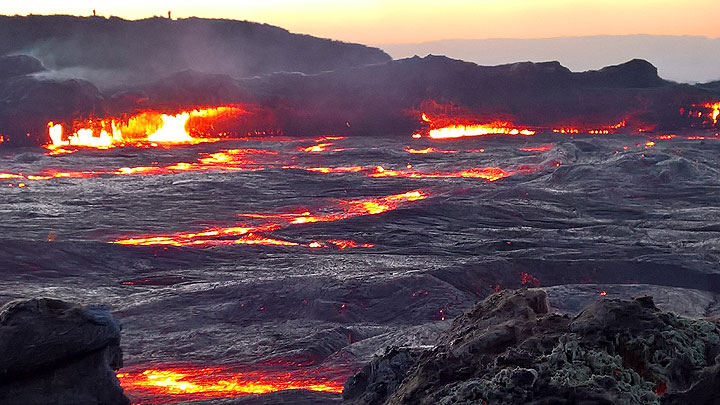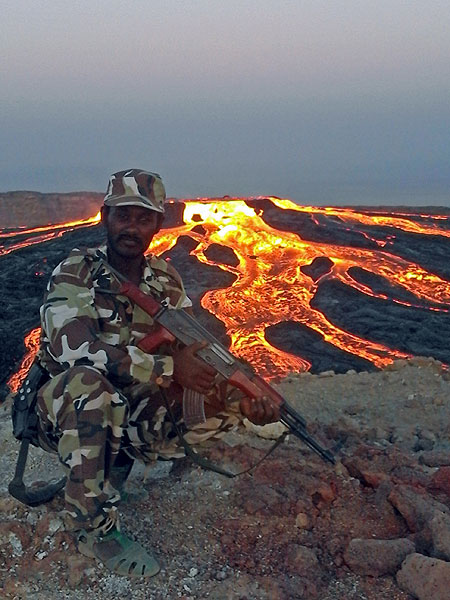Erta Ale (Ethiopia) volcano news:
Erta Ale volcano (Ethiopia) activity update: eruption continues from both summit and flank lava lake
Sunday Apr 02, 2017 17:04 PM | BY: T

Erta Ale's eruption on SENTINEL 2 satellite imagery on March 30th (image: SENTINEL2 / ESA-Copernicus data; Composition / annotations: Culture Volcan)

The flank lava lake and boundaries of the area covered by lava overflow since 10 March (image: SENTINEL2 / ESA / Copernicus; Composition / annotations: Culture Volcan)
According to ground information and fresh high-resolution satellite imagery analyzed by Culture Volcan, the eruption continues to be significant and occurs from both the summit (lava lake in the southern pit crater) AND the fissure eruption site on the southern rift axis.
The summit lava lake, which first had dropped to about 100 m depth at the beginning of the flank eruption, had again risen to 40-50 m below its rim when observed by our latest group to the area in late February. The collapsed northern crater showed a short-lived heat signal around 10 March, suggesting a brief phase of activity (lava effusion ?) there, but this seems to have ceased.
The most significant activity is occurring on the southern rift at the site of the 21 Jan fissure eruption. The vents feed both a large second lava lake, approx. 175x80m wide, and a growing lava flow field to the northeast, with a width of approx. 1500 m and its most advanced from about 3500 m distance.
A gap in thermal signal between the lava lake and the active flow field, likely pahoehoe type similar to Kilauea volcano on Hawaii, suggests that the lava flows through a tube on the first part of the distance to the front.
Successive overflows of the flank lava lake seem to have progressively built up a vast, broad shield around it. Judging from satellite data, overflows from the lake have covered an area of almost 1 million square meters.
- All news about: Erta Ale volcano
- Information about: Erta Ale volcano
---
Links / Sources:
Links / Sources:
- Un point sur l'activité des volcans Klyuchevskoy et Erta Ale (Culture Volcan)
Previous news
 |
Wednesday, Feb 08, 2017
A story in pictures of Erta Ale volcano's intense lava lake overflowing phase as witnessed by participants from our recent Volcano Special tour during 16-19 January 2017. ... [more]
 |
Friday, Jan 27, 2017
A new Landsat 8 satellite image from yesterday published by Nasa's Earth Observatory site shows the location of the new flank eruption at Erta Ale. ... [more]
 |
Thursday, Jan 26, 2017
The flank eruption has been confirmed and it is still going on strong. ... [more]
 |
Wednesday, Jan 25, 2017
News have come in about a fissure eruption at the SE flank of the volcano, approx. 7 km distance from the summit caldera and its lava lake (which partially collapsed on and after 20 Jan). ... [more]
Tuesday, Jan 24, 2017
The volcanic activity at the shield volcano in the Danakil desert has been at extraordinary and very elevated levels recently. Participant returning from our recent eruption special tour (14-20 Jan) reported that during their stay 16-20 Jan, the lava lake's surface level has been undergoing rapid and large variations, producing massive lava lake overflows when high and intense spattering when low. ... [more]


